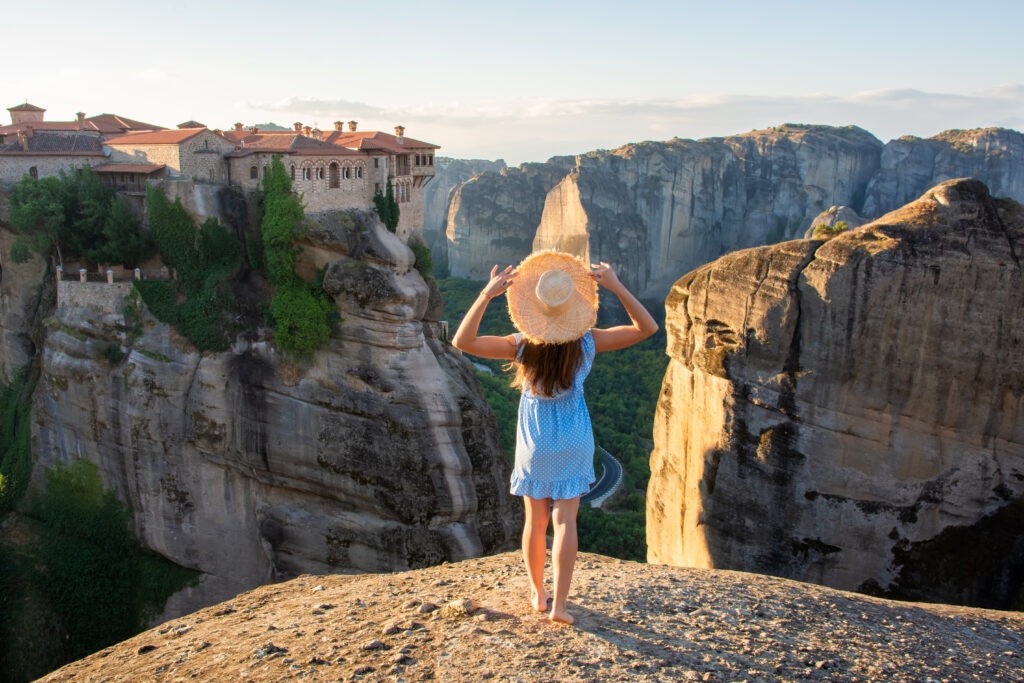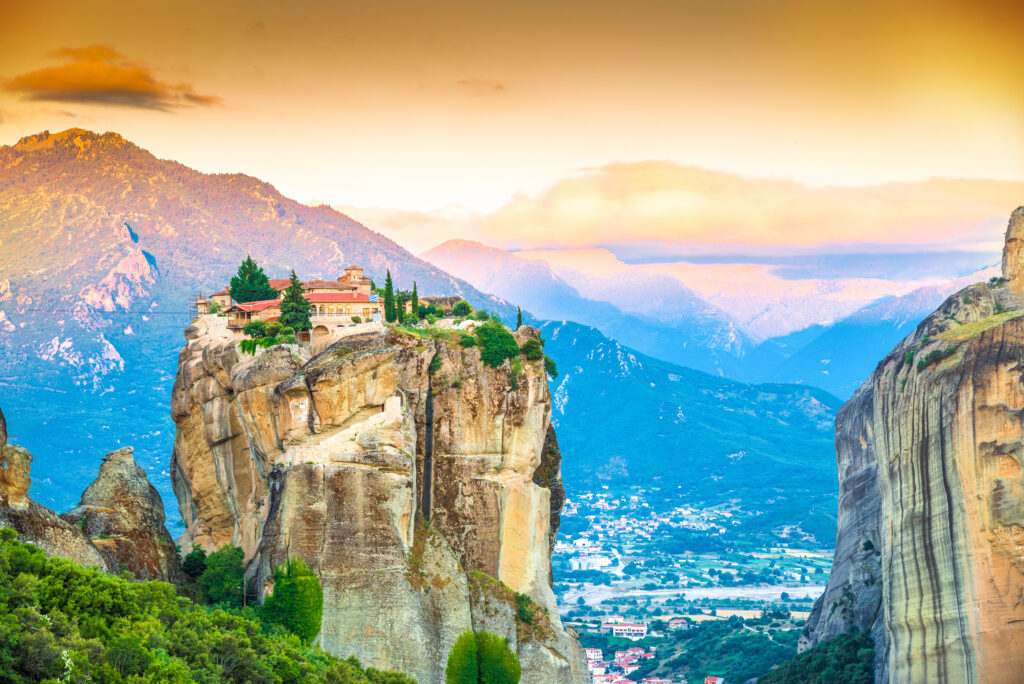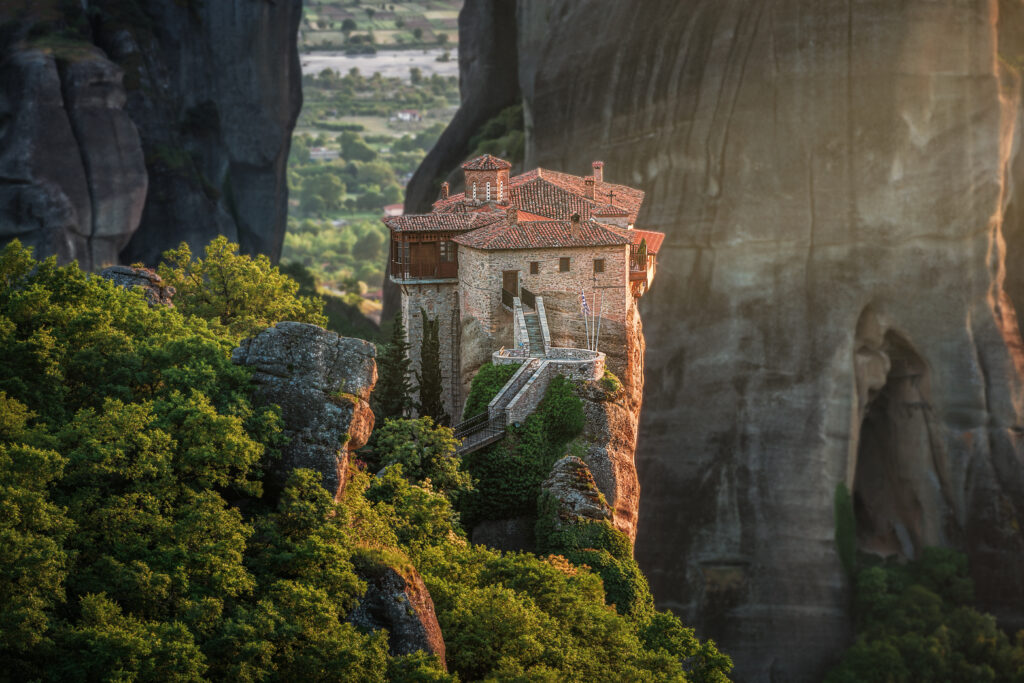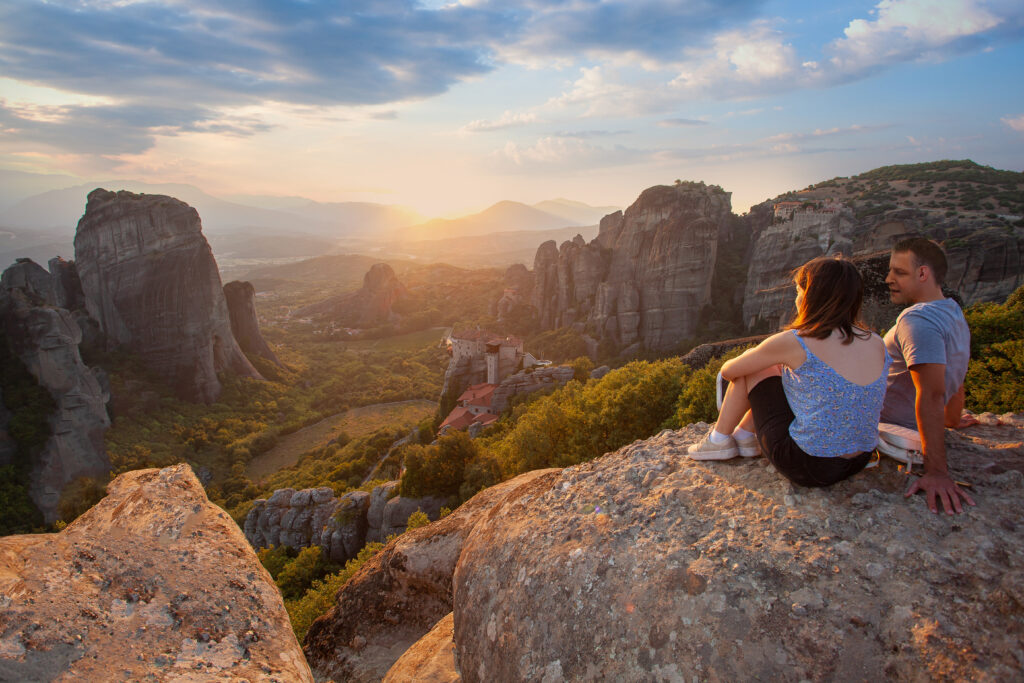
A visit to the monasteries of Meteora is one of Greece's must-sees. These Orthodox monasteries have been a UNESCO World Heritage Site since 1998. What's more, they can be reached in less than 3 hours by air from France.
In the heart of the Thessalian plains, these monasteries stand atop almost inaccessible rocky peaks. Indeed, when they were built in the 11th century, the monks sought to withdraw from the world. At the height of the Christianization of Meteora in the 11th century, there were 24 monasteries! Today, only 6 have survived, the rest having fallen into ruin. This veritable Greek archaeological site is all the more striking for having been inaccessible for so long. Originally, access to the summit was by gondola only.
How to get to Meteora from Athens or Thessaloniki?

To get to Meteora from Athens:
- By car: take the A1 freeway north for around 200 km, then follow the A3 for 100 km. Finally, exit at Trikala, then follow the signs to Meteora. Allow 4-5 hrs.
- By train: take the train from Athens Larissis station to Kalambaka station.
- By bus: depending on the season, you'll need to take a bus to Trikala or Kalambaka, where there are 3 departures a day to Meteora.
- With an agency: tour operators remain by far the most comfortable option, albeit more expensive. Various agencies offer to pick you up from your hotel in Athens and take you directly to visit the monasteries of Meteora, often accompanied by a guide, and with meal options. We recommend this guided tour from Athens, including lunch in a local restaurant.
How to get to Meteora from Thessaloniki:
- By car: take the A1 very briefly out of town, then follow the A2 for 150 km to the Kalambaka exit. Allow 2 hrs 30 min.
- By train: take a train to Larissa station, then take a cab.
- By bus: there are buses between Thessaloniki and Meteora, often quite long as they pass through Trikala.
- With an agency: again, this is the simplest option, as the operator takes care of the transport. We recommend this guided bus tour to Meteora from Thessaloniki.
What to see and do in Meteora?

There are 6 main monasteries to visit, which we present here from the most to the least unmissable:
- The Grand Meteora: the oldest and largest, it dates back to 1382 and is perched at 536m. It's also the only one to have remained occupied since its creation, making it a true Greek must-see, and the most famous monastery. If you had to see only one, this would be it.
- Varlaam: dating from 1536, it boasts impressive post-Byzantine frescoes.
- Roussanou: dedicated to Saint Barbara, this convent, which is still in use, is only partially open to visitors. Yet it is one of the most beautiful and authentic.
- Agios Stefanos (St. Stephen's): this women's monastery is the most accessible of all, as it is located not on a rocky outcrop, but above a cliff. For this reason, it is very popular.
- Agía Triáda (Holy Trinity): unlike the previous one, this is the most difficult to access, as it is perched on top of a rocky outcrop. To reach it, you'll have to climb some 150 steps. But this isolation makes it one of the most beautiful landscapes in the Mediterranean.
- Agios Nikolaos (St. Nicholas): popular for its frescoes and panoramic views, but not a must-see due to its small size.
As well as visiting the monasteries of Meteora, the site lends itself very well to hiking, particularly in spring when it's not yet too hot, andin autumn. Maps of the trails are available from tourist information points and most hotels. Sports enthusiasts will also enjoy cycling and climbing.
What are the different options for visiting the Meteora monasteries?
When it comes to visiting the monasteries of Meteora, you can choose to be accompanied by a guide, or go it alone. There are a number of different options available to you:
- Visiting the Meteora Monasteries on your own: you'll need to travel with your own vehicle or by public transport.
- A bus package: many agencies offer this service, with all your transportation organizedfrom Thessaloniki, Athens or Kalambaka, from your hotel to the Meteora Monasteries and between each monastery.
- Two days from Athens: hotel included. One-day packages are also available, but they involve driving 8 to 10 hours during the day. So it's best to devote two days to it.
- More complete excursions: some agencies offer more complete excursions, allowing you not only to visit the Meteora monasteries, but also to take part in hikes or discover beautiful Greek villages.
Practical information you need to know before visiting the Meteora monasteries

Before visiting the monasteries of Meteora, there are a number of practical points to bear in mind:
- It's best to visit Meteora in mid-season, particularly in spring or autumn, to avoid the heat and crowds.
- Climbing the monumental staircases is often very physical, and requires good footwear. If you have mobility problems or are traveling with children, Agios Stefanos is the place to go.
- Due tothe religious nature of the site, it is compulsory to cover arms and legs. Remember to bring a shawl and pants if you're a man, or a long skirt if you're a woman (pants are forbidden to women), otherwise scarves will be lent to you on site, sometimes at a charge.
- Entrance to each monastery costs €3.
How long does it take to visit Meteora?
Depending on your pace, you should devote one or two days to visiting Meteora, with 3 to 4 monasteries visited per day. The monasteries are very close to one another. There's no need to visit all 6, which could quickly become redundant.
What are the opening hours of the monasteries?
Here are the opening times for each monastery. They are divided into a high season from April1 to October 31 and a low season from November1 to March 31.
- Le Grand Météore: 9:30 a.m. to 3 p.m. in high season and 9:30 a.m. to 2 p.m. in low season. Closed on Tuesdays, Wednesdays and Thursdays in low season.
- Varlaam : 9 a.m. to 4 p.m. in high season, 9 a.m. to 3 p.m. in low season. Closed Fridays and Thursdays in low season.
- Agios Stefanos (Saint-Etienne): 9:00 a.m. to 1:30 p.m. then 3:30 p.m. to 5:30 p.m. in high season, and 9:30 a.m. to 1 p.m. then 3 p.m. to 5 p.m. in low season. Closed on Mondays.
- Agía Triáda (Holy Trinity): 7 a.m. to 7 p.m. in high season, 10 a.m. to 4 p.m. in low season. Closed on Thursdays.
- Roussanou: 9 a.m. to 3:30 p.m. in high season and 9:30 a.m. to 2 p.m. in low season. Closed on Wednesdays.
- Agios Nikolaos (St. Nicholas): 9 a.m. to 5 p.m. in high season and 9 a.m. to 4 p.m. in low season, except Sundays from 9:30 a.m. onwards. Open every day.
Where to eat around the Meteora monasteries?
The best place to eat in Meteora is in the towns of Kalambaka or Kastraki, which are full of options. The best options are
- The Meteora tavern in Kastraki: a pitcher of local wine accompanies specialties cooked with passion and served on a large terrace lulled by birdsong.
- The Gardenia tavern in Kastraki. Here, dishes are prepared by the whole family: in the courtyard, aunts and grandmothers peel vegetables, and the grandson serves customers! Prices defy all competition.
- The Archontariki restaurant in Kalambaka, a typical tavern frequented by locals, where you can sample traditional Greek dishes.
- Panellinion taverna in Kalambaka, a taverna on the main road to Meteora where you can enjoy excellent Greek specialties on the large terrace next to the fountain overlooking the rocks.
- The Valia Calda restaurant in Kalambaka.
Tempted? Take a look at our airfares and book now!


